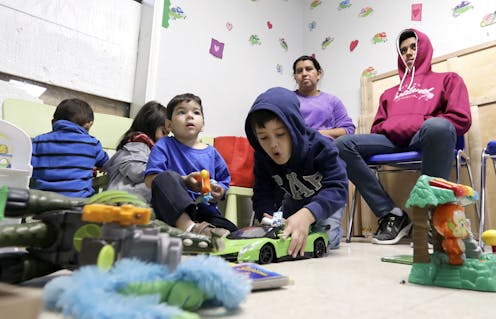The long history of separating families in the US and how the trauma lingers
The US has a long history of separating families. Research shows the long-term effects of that trauma.

During the last few weeks, hundreds of families have been separated, following the Trump administration’s “zero tolerance” policy towards illegal immigrants. Even though the separations have reportedly stopped, it is not clear when the families will be unified. There are also reports of children being possibly put in foster homes and at least one teenager missing, after walking out of a shelter.
This is not the first time that children have been separated. Exclusion and separation has impacted African-Americans during slavery, Native Americans during the Trail of Tears, and Japanese-Americans during internment, to name a few.
As a scholar who is actively engaged in child protection research and who examines the unnecessary removals of children from their parents, I am all too aware that the repercussions of such policies often take a lifetime to undo.
History of separating families
During the years of slavery, there was daily buying and selling of children from their enslaved parents. No legal restraints existed on slave owners, who chose to dispose of their property as they saw fit.
Another period of state-sanctioned separations was in the 1800s, after President Andrew Jackson authorized the Indian Removal Act. Native Americans, mostly youth, were forcibly taken out of their homes and communities and asked to walk for miles to a specially designated “Indian territory.” Thousands died on that journey. It has since been named the “Trail of Tears.”
The government, nonetheless went ahead with its policies and mandated that Native American children be educated apart from their families in boarding schools. This was a method of creating a distance between children and their Native American parents so that they would slowly let go of their native values – what scholars today describe as forced assimilation.
This practice went on until the passing of the Indian Child Welfare Act of 1978 when Native American parents were given the legal right to refuse boarding school education.
The internment of Japanese-Americans was also a time of enactment of exclusionary policies by the American government. President Roosevelt ordered that Japanese, many of them United States citizens, be forcibly removed and held in camps. Children, even infants, were placed in interment camps with their parents, and sometimes without.
As is being done today, these separations were staunchly defended and rationalized, without much consideration of the negative and long-lasting trauma.
The long-term impact
Recent research on the impact of family separation during slavery focuses on the trauma that has been passed down over the years.
Scholar Joy DeGruy, in her seminal book “Post Traumatic Slave Syndrome,” describes the impact of that history on black families today.
It is “common sense,” adds DeGruy, who has spent many years researching the multigenerational trauma, that hundreds of people who endured slavery would continue to pass on behaviors, such as anger, violence and shame, down to contemporary generations.
Scholars have also researched the impact of American Indian boarding schools. Their findings included reports of abuse in boarding school and how that manifested in their later years. As children, they were found to have high levels of depression. Research has also linked the adverse childhood experience of boarding school with difficulty in managing stress as adults.
Within the foster care system, scholars have long researched the harm in multiple placements, meaning moving children from one foster care placement to another. Children who experience such unstable placement experience, after being separated from their families, suffer from profound distress and a loss of belonging.
The trauma of the separation impacts physical and psychological development into adulthood. This essentially means the healthy development of a child is disrupted in many ways.
Separation of families in 2018
The consequences of adverse childhood experiences can be minimized if a child is in a supportive, loving and nurturing environment where they feel safe and are able to acquire appropriate ways to cope.
These past comparisons bring us to what is occurring today. President Trump’s executive order has stopped any additional separations, but it does not undo the damage that has already been set in motion.
Jessica Pryce does not work for, consult, own shares in or receive funding from any company or organization that would benefit from this article, and has disclosed no relevant affiliations beyond their academic appointment.
Read These Next
The marketing genius of Spotify Wrapped
Spotify has hit a marketing sweet spot: Users feel compelled to share their annual listening habits…
A hard year for federal workers offers a real-time lesson in resilience
During a year of extraordinary uncertainty, workers built resilient networks within and across boundaries…
Yes, the government can track your location – but usually not by spying on you directly
A privacy researcher breaks down how your phone reveals your location, how that data is collected and…




